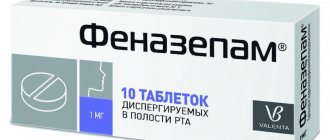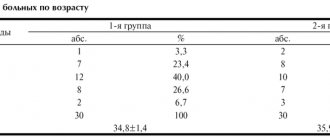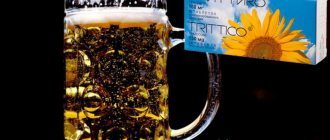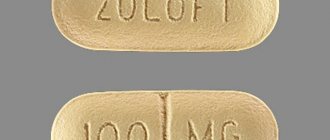Triftazin is one of the brightest representatives of the class of antipsychotics. It effectively eliminates mental disorders accompanied by hallucinations and delusions, and also has a pronounced antiemetic effect. In minimal doses, this remedy has a stimulating effect on the nervous system, effectively coping with low mood and depression.
But it has a serious drawback - it is the ability to provoke a Parkinson-like state, manifested by trembling of the hands, facial muscles and a shuffling gait.
Situations limiting the use of Triftazine
However, Triftazin has a number of contraindications. They must be known to the patient to whom this drug is prescribed. If he has any of the following conditions, then he must inform the doctor about this (so that he can select another, more suitable antipsychotic):
- Traumatic brain injury
- Liver pathology, because most of Triftazin is metabolized in it
- Kidney pathology (products of drug metabolism are excreted in the urine)
- Exacerbation of peptic ulcer
- High blood pressure values
- Increased risk of thrombosis (prosthetic heart valves, varicose veins, increased blood clotting)
- Glaucoma in which the anterior chamber angle is closed
- Prostatic adenoma
- Hypothyroidism (reduced production of thyroid hormones).
Pregnant and breastfeeding women should also not take the drug due to the negative effects on the child.
Professional help! Don’t delay contacting the clinic!
Triftazin 5 mg 50 pcs. film-coated tablets
pharmachologic effect
Antipsychotic (neuroleptic).
Composition and release form Triftazin 5 mg 50 pcs. film-coated tablets
Tablets - 1 tablet:
- Active substance: Trifluoperazine dihydrochloride (triftazine hydrochloride) in terms of triftazine base - 0.0050 g / 0.0100 g;
- Excipients: sucrose (sugar) - 0.115088 g / 0.257976 g, potato starch - 0.035000 g / 0.070000 g, colloidal silicon dioxide (aerosil) - 0.002748 g / 0.005496 g, calcium stearate - 0.001000 g / 0.002000 g, gelatin - 0.000065 g / 0.000130 g, povidone (low molecular weight medical polyvinylpyrrolidone 12600 ± 2700) - 0.002666 g / 0.005332 g, magnesium hydroxycarbonate (magnesium carbonate main) - 0.017102 g / 0.034204 g, titanium dioxide (titanium dioxide pigment) - 0.000350 g / 0.000700 g, talc - 0.000499 g / 0.000998 g, indigo carmine - 0.000308 g / 0.000616 g, beeswax - 0.000174 g/0.000348 g.
10 coated tablets in a blister pack made of polyvinyl chloride film and printed varnished aluminum foil.
50 or 100 film-coated tablets in a glass jar, sealed with a plastic lid or in a polymer jar.
Each jar or 5 blister packs along with instructions for use are placed in a cardboard pack.
Description of the dosage form
Blue-coated tablets with marbling, biconvex, round, with a smooth surface. The cross-section of the tablets is white with a creamy tint.
Directions for use and doses
Take orally after meals. Doses are selected individually according to the severity of the condition. When the maximum therapeutic effect is achieved, the dose is gradually reduced to a maintenance dose.
For psychotic diseases, 5 mg is usually prescribed 2 times a day, then over 2-3 weeks the dose is gradually increased to 15-20 mg per day, divided into 2-3 doses. To obtain the desired therapeutic effect and improve the patient's condition, it usually takes 2-3 weeks. The maximum daily dose is 40 mg.
At the first stage of dose selection in elderly, depleted, weakened patients and children, it is advisable to use dosage forms with a lower dosage of trifluoperazine. Elderly, as well as depleted and weakened patients require a lower initial dose, which, if necessary, is gradually increased, taking into account tolerability.
Pharmacodynamics
Antipsychotic drug (neuroleptic), piperazine derivative of phenothiazine. It also has a sedative, anti-hiccup, cataleptic, hypotensive, hypothermic and weak m-anticholinergic effect.
The antipsychotic effect is due to the blockade of D2-dopamine receptors of the mesolimbic and mesocortical systems, has a blocking effect on alpha-adrenergic receptors and suppresses the release of hormones of the hypothalamus and pituitary gland (with blockade of dopamine receptors, the release of prolactin by the pituitary gland increases). Blockade of vascular alpha-adrenergic receptors determines its hypotensive effect. Antiemetic effect - blockade of peripheral and central (chemoreceptor trigger zone of the cerebellar vomiting center) D2-dopamine receptors, as well as blockade of the endings of the vagus nerve in the gastrointestinal tract.
The sedative effect is due to the blockade of adrenergic receptors in the reticular formation of the brain stem.
Hypothermic effect - blockade of dopamine receptors in the hypothalamus.
Structurally similar to chlorpromazine, has higher activity, and is better tolerated. The sedative effect and effect on the autonomic nervous system is less pronounced than that of other phenothiazine derivatives, while the extrapyramidal and antiemetic effects are stronger.
Pharmacokinetics
Absorption is high. Bioavailability after oral administration is 35% (has a “first pass” effect through the liver). Communication with plasma proteins is 95%. The time required to achieve maximum concentration is 2-4 hours. Penetrates through the blood-brain barrier, the placenta and into breast milk. Intensively metabolized in the liver, the metabolites are pharmacologically inactive. The half-life is 15 - 30 hours. It is excreted mainly by the kidneys (in the form of metabolites) and with bile. During hemodialysis, it is dialyzed weakly (high binding to plasma proteins).
Indications for use Triftazin 5 mg 50 pcs. film-coated tablets
Schizophrenia (with productive and negative symptoms) and other psychotic diseases occurring with psychomotor agitation, hallucinatory and delusional disorders.
Contraindications
Hypersensitivity to the components of the drug (including other phenothiazine derivatives), severe cardiovascular diseases (decompensated chronic heart failure, arterial hypotension), severe depression of the function of the central nervous system (including against the background of drugs) and comatose states any etiology, traumatic brain injury, progressive diseases of the brain and spinal cord, suppression of bone marrow hematopoiesis, impaired hematopoiesis, severe liver failure, childhood.
Carefully:
Alcoholism (increased susceptibility to hepatotoxic reactions), angina pectoris, valvular heart lesions that limit the minute blood circulation (severe arterial hypotension may develop), breast cancer (as a result of phenothiazine-induced prolactin secretion, the potential risk of disease progression and resistance to treatment with endocrine and cytotoxic drugs increases). - static drugs), angle-closure glaucoma, prostatic hyperplasia with clinical manifestations, mild to moderate liver failure, renal failure, gastric and duodenal ulcers during exacerbation; diseases accompanied by an increased risk of thromboembolic complications; Parkinson's disease (extrapyramidal effects increase); epilepsy; myxedema; chronic diseases accompanied by breathing problems (especially in children); Reye's syndrome (increased risk of developing manifestations of hepatotoxicity in children and adolescents); cachexia, vomiting (the antiemetic effect of phenothiazines may mask vomiting associated with overdose of other drugs), old age. While taking the drug, exposure to high temperatures should be avoided (possible disruption of thermoregulation).
Neuroleptic malignant syndrome can occur at any time during treatment with antipsychotic drugs and can be fatal.
Application of Triftazin 5 mg 50 pcs. film-coated tablets during pregnancy and breastfeeding
The drug is contraindicated during pregnancy and breastfeeding.
special instructions
To correct extrapyramidal disorders, antiparkinsonian drugs are used - trihexyphenidyl and others; dyskinesias are relieved subcutaneously by administering 2 ml of a 20% caffeine solution and 1 ml of a 0.1% atropine solution).
The drug, having a cardiotoxic effect, can cause arterial hypotension, deterioration of cardiac hemodynamics (pulmonary edema, ventricular fibrillation and, as a result, sudden death) in elderly patients with psychosis.
In elderly patients, irreversible dyskinesias may develop. If signs of tardive dyskinesia or neuroleptic malignant syndrome appear, treatment should be discontinued.
During therapy with phenothiazines, it is possible to obtain false-positive tests for phenylketonuria.
Prescription of phenothiazines should be discontinued at least 48 hours before the proposed myelography (resumption is possible after 24 hours).
Impact on the ability to drive vehicles and operate machinery
During treatment, it is not recommended to drive vehicles, as well as engage in activities that require psychomotor speed and precise movements.
Overdose
Symptoms: areflexia or hyperreflexia, blurred vision, cardiotoxic (arrhythmia, heart failure, low blood pressure, shock, tachycardia, QRS changes, ventricular fibrillation, cardiac arrest), neurotoxic effects including agitation, confusion, seizures, disorientation, drowsiness , stupor or coma; mydriasis, dry mouth, hyperpyrexia or hypothermia, muscle rigidity, vomiting, pulmonary edema or respiratory depression.
Treatment: symptomatic: to eliminate extrapyramidal disorders, antiparkinsonian drugs from the group of central m-anticholinergics, barbiturates or diphenhydramine are used. If stimulants are needed, it is better to use amphetamine, dextroamphetamine or caffeine. Avoid stimulants that can cause seizures (picrotoxin, pentylenetetrazole). With the development of arterial hypotension, norepinephrine and phenylephrine are indicated. The use of other vasopressor agents (including adrenaline) is not recommended, because triphthazine metabolites can alter their action, leading to an even greater decrease in blood pressure. Monitoring the function of the cardiovascular system for at least 5 days, the function of the central nervous system, breathing, measuring body temperature, consulting a psychiatrist. Dialysis is ineffective. It is not allowed to induce vomiting to empty the stomach.
Side effects Triftazin 5 mg 50 pcs. film-coated tablets
From the nervous system: drowsiness, dizziness, insomnia (at the beginning of treatment), with prolonged use in high doses (0.5 -1.5 g / day) - akathisia, dystonic extrapyramidal reactions (spasms of the muscles of the face, neck and back, tic-like movements or jerking, twisting movements of the body, inability to move the eyes, weakness in the arms and legs), parkinsonism (difficulty speaking and swallowing, loss of balance control, mask-like face, shuffling gait, stiffness in the arms and legs, tremors of the hands and fingers), tardive dyskinesia (smacking and puckering of lips, puffing out of cheeks, rapid or worm-like movements of the tongue, uncontrolled chewing movements, uncontrolled movements of arms and legs), neuroleptic malignant syndrome (seizures, difficulty or rapid breathing, rapid or irregular pulse, hyperthermia, unstable blood pressure, increased sweating, loss of urinary control, severe muscle rigidity, unusually pale skin, excessive fatigue and weakness), phenomena of mental indifference, delayed reaction to external irritations and other mental changes, convulsions.
From the genitourinary system: urinary retention, decreased potency, frigidity (at the beginning of treatment), decreased libido, ejaculation disorders, priapism, oliguria.
From the endocrine system: hypo- or hyperglycemia, hyperprolactinemia, galactorrhea, swelling or pain in the mammary glands, gynecomastia, amenorrhea, dysmenorrhea, weight gain.
From the digestive system: loss of appetite, dry mouth, constipation (at the beginning of treatment), bulimia or anorexia, nausea, vomiting, diarrhea, gastralgia, cholestatic jaundice, hepatitis, intestinal paresis.
From the senses: visual impairment - accommodation paresis (at the beginning of treatment), retinopathy, clouding of the lens and cornea, blurred visual perception.
From the hematopoietic organs: inhibition of bone marrow hematopoiesis (thrombocytopenia, leukopenia, agranulocytosis (4-10 weeks of treatment), pancytopenia, eosinophilia), hemolytic anemia.
Laboratory indicators: false-positive tests for pregnancy and phenylketonuria.
From the cardiovascular system: tachycardia, decreased blood pressure (including orthostatic hypotension) especially in elderly patients and persons with alcoholism (at the beginning of treatment), heart rhythm disturbances, prolongation of the QT interval, decrease or inversion of the T wave, increased frequency of attacks of angina pectoris (against the background of increased physical activity).
Allergic reactions: skin rash, urticaria, exfoliative dermatitis, angioedema.
Other: skin coloring from blue-violet to brown, photosensitivity, discoloration of the sclera and cornea, decreased tolerance to high temperatures (up to the development of heat stroke - hot dry skin, loss of the ability to sweat, confusion), myasthenia gravis.
Drug interactions
Weakens the effects of levodopa and phenamine derivatives, the latter reduce the antipsychotic activity of trifluoperazine. Enhances the effect of ethanol and other drugs that depress the central nervous system (general anesthesia, narcotic analgesics, opioids, barbiturates), as well as atropine.
When taken simultaneously with antiepileptic drugs (including barbiturates), trifluoperazine reduces their effect (lowers the epileptic threshold).
Reduces the effect of anorexigenic drugs (with the exception of fenfluramine).
Reduces the effectiveness of the emetic effect of apomorphine, enhances its inhibitory effect on the central nervous system.
Increases plasma concentrations of prolactin and interferes with the action of bromocriptine. When used together with tricyclic antidepressants, maprotiline, monoamine oxidase inhibitors, it is possible to prolong and intensify the sedative and anticholinergic effects, with thiazide diuretics - the occurrence of electrolyte imbalance, with lithium preparations - a decrease in absorption in the gastrointestinal tract, an increase in the rate of excretion of lithium by the kidneys, increased severity extrapyramidal disorders, early signs of lithium intoxication (nausea and vomiting) may be masked by the antiemetic effect of trifluoperazine.
When combined with beta-blockers, it enhances the hypotensive effect, increasing the risk of developing irreversible retinopathy, arrhythmias and tardive dyskinesia. Reduces the effect of indirect anticoagulants.
The use of alpha and beta adrenergic agonists (epinephrine) and sympathomimetics (ephedrine) can lead to a paradoxical decrease in blood pressure. Amitriptyline, amantadine, H1-histamine receptor blockers and other drugs with an m-anticholinergic effect increase m-anticholinergic activity. Aluminum and magnesium-containing antacid drugs or antidiarrheal adsorbents reduce absorption.
Antithyroid drugs increase the risk of developing agranulocytosis. Probucol, astemizole, cisapride, disopyramide, erythromycin, pimozide, procainamide, quinidine further prolong the QT interval, which increases the risk of developing ventricular tachycardia.
With the simultaneous use of phenothiazides with propranolol, an increase in the concentration of both drugs is observed.
Possible Adverse Effects
Triftazin has a complex effect on the human body, exhibiting the ability to bind to receptors located not only in the nervous system. This makes it possible to develop a variety of side effects. Therefore, any deviation in normal health during treatment with Triftazin is an indication for consultation with a doctor. You may need to replace the drug with another one.
Triftazin, 10 pcs., 1 ml, 2 mg/ml, solution for intramuscular administration
Disorders of the blood and lymphatic system: inhibition of bone marrow hematopoiesis (thrombocytopenia, leukopenia, agranulocytosis (4-10 weeks of treatment), pancytopenia, eosinophilia), hemolytic anemia.
Immune system disorders: skin rash, urticaria, exfoliative dermatitis, angioedema, photosensitivity.
Endocrine system disorders: hypo- or hyperglycemia, glucosuria, hyperprolactinemia, galactorrhea.
Metabolic and nutritional disorders: weight gain.
Mental disorders: phenomena of mental indifference, delayed reaction to external stimuli and other mental changes, seizures, bulimia or anorexia.
Nervous system disorders: headache, drowsiness, dizziness, insomnia (at the beginning of treatment), with long-term use in high doses (0.5–1.5 g/day) - akathisia, dystonic extrapyramidal reactions (spasms of the muscles of the face, neck and back, tic-like movements or jerking, twisting movements of the body, inability to move the eyes, weakness in the arms and legs), parkinsonism (difficulty speaking and swallowing, loss of balance control, mask-like face, shuffling gait, stiffness of the arms and legs, trembling of the hands and fingers ), tardive dyskinesia (smacking and wrinkling of lips, puffing out of cheeks, rapid or worm-like movements of the tongue, uncontrolled chewing movements, uncontrolled movements of arms and legs), neuroleptic malignant syndrome (convulsions, difficulty or rapid breathing, hyperthermia, increased sweating, severe muscle rigidity, unusually pale skin, excessive fatigue and weakness), tremors.
Violations of the organ of vision: visual impairment - accommodation paresis (at the beginning of treatment), retinopathy, clouding of the lens and cornea, blurred visual perception, discoloration of the sclera and cornea.
Cardiac disorders: tachycardia, heart rhythm disturbances, rapid heartbeat or irregular pulse, changes in the electrocardiogram, prolongation of the Q-T interval, decrease or inversion of the T wave, increased frequency of angina attacks (against the background of increased physical activity), cardiac arrest.
Vascular disorders: unstable blood pressure, decreased blood pressure (including orthostatic hypotension), especially in elderly patients and persons with alcoholism (at the beginning of treatment).
Gastrointestinal disorders: loss of appetite, dry mouth, constipation (at the beginning of treatment), bulimia or anorexia, nausea, vomiting, diarrhea, gastralgia, intestinal paresis.
Disorders of the liver and biliary tract: cholestatic jaundice, hepatitis, hepatotoxicity.
Disorders of the skin and subcutaneous tissues: discoloration of the skin from blue-violet to brown, decreased tolerance to high temperatures (up to the development of heat stroke - hot dry skin, loss of the ability to sweat), myasthenia gravis.
Renal and urinary tract disorders: urinary retention, loss of urinary control, oliguria.
Disorders of the genital organs and mammary gland: swelling or pain in the mammary glands, gynecomastia, amenorrhea, dysmenorrhea, decreased libido, decreased potency, frigidity (at the beginning of treatment), ejaculation disorders, priapism.
Impact on the results of laboratory and instrumental studies: false-positive tests for pregnancy and phenylketonuria.
General disorders and disorders at the injection site: infiltrates may occur, and contact dermatitis may occur if liquid forms come into contact with the skin.
When taking phenothiazine antipsychotics, cases of sudden death (including those possibly caused by cardiac causes) have been reported.
What is the danger of exceeding the recommended dose?
When taking tablets, you must follow the recommended dosage regimen, because Exceeding it quickly leads to an overdose. It poses a threat to human health and life, manifesting itself:
- Cardiac arrhythmias;
- Cramps;
- Increased sleepiness;
- Dry mouth;
- Pupil dilation;
- Respiratory depression, etc.
If such symptoms appear during treatment with Triftazin, you should immediately visit your psychiatrist. To cope with the signs of an overdose, the doctor will prescribe specific medications. Relying on independent normalization of the condition is utopian; it always requires treatment.
Triftazina is an effective treatment for many mental illnesses. But following the dosages recommended by your doctor and paying close attention to your well-being will help make it safe (if it changes, it is better to consult a specialist).
Triphtazin
From the nervous system:
drowsiness, dizziness, insomnia (at the beginning of treatment), with long-term use in high doses (0.5 -1.5 g / day) - akathisia, dystonic extrapyramidal reactions (spasms of the muscles of the face, neck and back, tic-like movements or twitching, bending trunk movements, inability to move eyes, weakness in arms and legs), parkinsonism (difficulty speaking and swallowing, loss of balance control, mask-like face, shuffling gait, stiffness in arms and legs, tremors of hands and fingers), tardive dyskinesia (smacking and puckering of lips , puffing out of the cheeks, rapid or worm-like movements of the tongue, uncontrolled chewing movements, uncontrolled movements of the arms and legs), neuroleptic malignant syndrome (seizures, difficulty or rapid breathing, rapid or irregular pulse, pyrexia, unstable blood pressure, increased sweating, loss of control over urination, severe muscle rigidity, unusually pale skin, excessive fatigue and weakness), phenomena of mental indifference, delayed reaction to external irritations and other mental changes, convulsions.
From the genitourinary system:
urinary retention, decreased potency, frigidity (at the beginning of treatment), decreased libido, ejaculation disorders, priapism, oliguria.
From the endocrine system:
hypo- or hyperglycemia, hyperprolactinemia, galactorrhea, swelling or pain in the mammary glands, gynecomastia, amenorrhea, dysmenorrhea, weight gain.
From the digestive system:
decreased appetite, dry mouth, constipation (at the beginning of treatment), bulimia or anorexia, nausea, vomiting, diarrhea, gastralgia, cholestatic jaundice, hepatitis, intestinal paresis.
From the senses:
visual impairment - accommodation paresis (at the beginning of treatment), retinopathy, clouding of the lens and cornea, blurred visual perception.
From the hematopoietic organs:
inhibition of bone marrow hematopoiesis (thrombocytopenia, leukopenia, agranulocytosis (4-10 weeks of treatment), pancytopenia, eosinophilia), hemolytic anemia.
Laboratory indicators:
false positive tests for pregnancy and phenylketonuria.
From the cardiovascular system:
tachycardia, decreased blood pressure (including orthostatic hypotension) especially in elderly patients and persons with alcoholism (at the beginning of treatment), heart rhythm disturbances, prolongation of the QT interval, decrease or inversion of the T wave, increased frequency of angina attacks (against the background of increased physical activity).
Allergic reactions:
skin rash, urticaria, exfoliative dermatitis, angioedema.
Other:
coloring of the skin from blue-violet to brown, photosensitivity, discoloration of the sclera and cornea, decreased tolerance to high temperatures (up to the development of heat stroke - hot dry skin, loss of the ability to sweat, confusion), myasthenia gravis.



